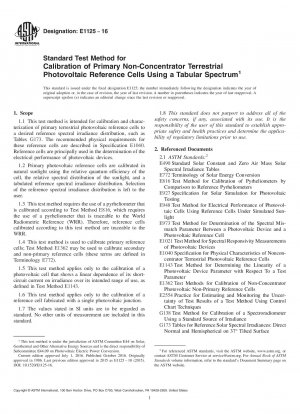ASTM E1125-16
Standard Test Method for Calibration of Primary Non-Concentrator Terrestrial Photovoltaic Reference Cells Using a Tabular Spectrum
- Standard No.
- ASTM E1125-16
- Release Date
- 2016
- Published By
- American Society for Testing and Materials (ASTM)
- Status
- Replace By
- ASTM E1125-16(2020)
- Latest
- ASTM E1125-16(2020)
- Scope
5.1 The electrical output of a photovoltaic device is dependent on the spectral content of the illumination source, its intensity, and the device temperature. To make standardized, accurate measurements of the performance of photovoltaic devices under a variety of light sources when the intensity is measured with a calibrated reference cell, it is necessary to account for the error in the short-circuit current that occurs if the relative quantum efficiency of the reference cell is not identical to the quantum efficiency of the device to be tested. A similar error occurs if the spectral irradiance distribution of the test light source is not identical to the desired reference spectral irradiance distribution. These errors are accounted for by the spectral mismatch parameter (described in Test Method E973), which is a quantitative measure of the error in the short-circuit current measurement. It is the intent of this test method to provide a recognized procedure for calibrating, characterizing, and reporting the calibration data for primary photovoltaic reference cells using a tabular reference spectrum.
5.2 The calibration of a reference cell is specific to a particular spectral irradiance distribution. It is the responsibility of the user to specify the applicable irradiance distribution, for example Tables G173. This test method allows calibration with respect to any tabular spectrum.
5.2.1 Tables G173 do not provide spectral irradiance data for wavelengths longer than 4 μm, yet pyrheliometers (see 6.1) typically have response in the 4–10 μm region. To mitigate this discrepancy, the Tables G173 spectra must be extended with the data provided in Annex A2.
5.3 A reference cell should be recalibrated at yearly intervals, or every six months if the cell is in continuous use outdoors.
5.4 Recommended physical characteristics of reference cells can be found in Specification E1040.
5.5 High-quality silicon primary reference cells are expected to be stable devices by nature, and as such can be considered control samples. Thus, the calibration value data points (see 9.3) can be monitored with control chart techniques according to Practice E2554, and the test result uncertainty estimated. The control charts can also be extended with data points from previous calibrations to detect changes to the reference cell or the calibration procedures.
1.1 This test method is intended for calibration and characterization of primary terrestrial photovoltaic reference cells to a desired reference spectral irradiance distribution, such as Tables G173. The recommended physical requirements for these reference cells are described in Specification E1040. Reference cells are principally used in the determination of the electrical performance of photovoltaic devices.
<......
ASTM E1125-16 Referenced Document
- ASTM E1021 Standard Test Methods for Measuring Spectral Response of Photovoltaic Cells
- ASTM E1040 Standard Specification for Physical Characteristics of Nonconcentrator Terrestrial Photovoltaic Reference Cells
- ASTM E1143 Standard Test Method for Determining the Linearity of a Photovoltaic Device Parameter with Respect To a Test Parameter
- ASTM E1362 Standard Test Method for Calibration of Non-Concentrator Photovoltaic Secondary Reference Cells
- ASTM E2554 Standard Practice for Estimating and Monitoring the Uncertainty of Test Results of a Test Method Using Control Chart Techniques
- ASTM E490 Standard Solar Constant and Zero Air Mass Solar Spectral Irradiance Tables
- ASTM E772 Standard Terminology Relating to Solar Energy Conversion
- ASTM E816 Standard Test Method for Calibration of Pyrheliometers by Comparison to Reference Pyrheliometers
- ASTM E927 Standard Specification for Solar Simulation for Terrestrial Photovoltaic Testing
- ASTM E948 Standard Test Method for Electrical Performance of Photovoltaic Cells Using Reference Cells Under Simulated Sunlight
- ASTM E973 Test Method for Determination of the Spectral Mismatch Parameter Between a Photovoltaic Device and a Photovoltaic Reference Cell
- ASTM G138 Standard Test Method for Calibration of a Spectroradiometer Using a Standard Source of Irradiance
- ASTM G173 Standard Tables for Reference Solar Spectral Irradiances: Direct Normal and Hemispherical on 37° Tilted Surface
- ASTM G183 Standard Practice for Field Use of Pyranometers, Pyrheliometers and UV Radiometers
ASTM E1125-16 history
- 2020 ASTM E1125-16(2020) Standard Test Method for Calibration of Primary Non-Concentrator Terrestrial Photovoltaic Reference Cells Using a Tabular Spectrum
- 2016 ASTM E1125-16 Standard Test Method for Calibration of Primary Non-Concentrator Terrestrial Photovoltaic Reference Cells Using a Tabular Spectrum
- 2010 ASTM E1125-10(2015) Standard Test Method for Calibration of Primary Non-Concentrator Terrestrial Photovoltaic Reference Cells Using a Tabular Spectrum
- 2010 ASTM E1125-10 Standard Test Method for Calibration of Primary Non-Concentrator Terrestrial Photovoltaic Reference Cells Using a Tabular Spectrum
- 2005 ASTM E1125-05 Standard Test Method for Calibration of Primary Non-Concentrator Terrestrial Photovoltaic Reference Cells Using a Tabular Spectrum
- 1999 ASTM E1125-99 Standard Test Method for Calibration of Primary Non-Concentrator Terrestrial Photovoltaic Reference Cells Using a Tabular Spectrum

Copyright ©2024 All Rights Reserved